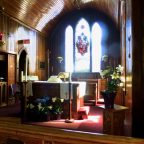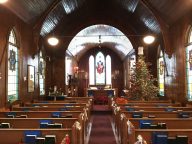On Statues, Idols and History, September 1, 2017
On Statues, Idols and History
Rev. Yme Woensdregt
I’m going to weigh in on something that has been in the news quite a bit lately. It is very prominent in the southern US, with reports of the removal of statues of Confederate generals as a way of trying to deal with the legacy of slavery.
But it’s not just an American thing. It has also been happening in Canada, dealing largely with monuments and buildings honouring people who played a shameful part in the legacy of our treatment of indigenous peoples.
Most recently, teachers in Ontario have approved a motion which they hope will open up a wide–ranging conversation about buildings and other public monuments honouring John A MacDonald. But there have been other protests. Mi’kmaq groups have long protested the statue of Edward Cornwallis in Halifax, and argued that it should be removed. In June, Prime Minister Trudeau renamed the Langevin Block; it’s now called the Office of the Prime Minister and the Privy Council Office.
Why these protests and changes? Langevin and MacDonald were two of the primary architects of the Indian Residential School system (IRS) which stripped indigenous peoples of their identity and culture. The stated purpose of the IRS was to “beat the Indian out of the child”, and engage in a process of assimilation. Residential schools stripped indigenous children of their heritage, ripped them from their families and forced them to become little white boys and girls.
It’s a shameful legacy. Two years ago, after listening to countless painful stories, the Truth and Reconciliation Commission called on all Canadians to begin a process of repenting of our past mistakes and to move into a new future marked by reconciliation with our indigenous brothers and sisters.
Cornwallis was a British military officer who founded Halifax. As governor of Nova Scotia, he issued a bounty on Mi’kmaq scalps in response to an attack on colonists. Some Mi’kmaq leaders have called his actions a form of genocide.
The conversation the Ontario teachers were looking for is beginning. It promises to be a loud and vociferous debate. Many voices are being raised against removing these statues or other memorials. We can’t forget history, they say, or erase it. We can’t change history, and these statues and memorials remind us of our history. One historian reminds us that “we have to view the past through the eyes of the past, not through today’s different standards of what is right and what is wrong.”
I disagree. It’s not a matter of forgetting, or changing, or erasing history. It’s about whom we choose to honour and memorialize.
In 2011, as part of the School District #5 Aboriginal Education Enhancement Agreement, Mount Baker school mounted the name of the school in the Ktunaxa language. Some people wondered out loud why we had to spend the money doing that. The reason is very simple—we live in the territory of the Ktunaxa Nation, and in this way, we honour our relationship with our Ktunaxa brothers and sisters. This public act is a very important symbol of cultural respect, collaboration, and a small step on the road to Reconciliation.
That leads me to the heart of why I agree with the removal of public memorials to people who acted in ways we now know to be wrong.
Let me use an analogy from the Bible. At the beginning of Exodus, we read that the Hebrews were enslaved in Egypt. They were forced to build supply cities for the Egyptians. Part of their work was to erect giant statues of gods, kings and queens who stared down at you from impressive heights. Think Sphinx.
Now what would it have been like to be a Hebrew slave looking up at these images? Not just the ones they had to build, but the images that surrounded them day in and day out. Everwhere they turned, another statue came into view, and each statue of a god or a king or a queen looked like the Egyptians, not like you. The statues were a mute witness to the power dynamic which was that the kings and queens of Egypt were placed in power by their gods. The statues were a daily reminder of the legitimization of the status quo. If you were a Hebrew slave, well your life just doesn’t matter.
When those Hebrew slaves escaped, and made their way to Sinai, the story goes that God told them not to build any statues or images. God said to them, “I don’t need your statuary.” Why not? Because God didn’t want to be tied to the political leaders. God didn’t want to be remade in the image of the ruling class. After all, human beings were made in the image of God, and God just didn’t want to take the chance that people might misunderstand and turn that equation around. If you want to see God, look at your neighbour.
Statues and monuments like this are not so much about “history”. They are expressions of power. They are a public statement that this is how things are, and this is the way things have always been meant to be.
Monuments honouring MacDonald and Cornwallis are memorials of a power structure which is no longer in play. We live in a different time, and there is much we can do to work towards being reconciled with our indigenous neighbours. They are a daily reminder of the cultural genocide sparked by leaders like them.
Some people say, “So take them down and put them in a museum.” I’m fine with that. Let them gather dust somewhere, along with the other idols to petty tyrant gods and egocentric rulers. Let children on field trips pass by them and wonder what spiritual power they had over those who created it.
And let those children know as well that they and all people are made in God’s image, and that no ruler, no petty god, can take their freedom from them.







